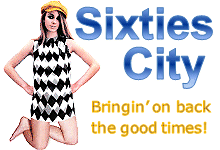


 |

|
 |
| Maps and original graphics are copyright Sixties City 2025 |
'The
Kings Road' is just one of several Sixties City articles and pages
that examine the birthplace of the 'Swinging Sixties' in London
The map is a stylised representation of the area and is not intended to show the precise relative positioning or sizing of premises Updated 4th January 2026 |
|
|
| Join
me for a walk down the Kings Road from
Sloane Square to where it becomes the New Kings Road, with the help
of a few explanatory and educational side notes on historic buildings,
occupants, the ubiquitous boutiques, some personal recollections and
many other features you may have come across if you had been there at
some time during the Sixties. Property
prices, especially at the east end of the road, soared during the 50s
and 60s. A shoe shop worth £4,500 in 1950 was worth £30,000 by 1967
and £45,000 in 1969! By
the early 1970s, planning applications for shops was in the region of
250 a year and it was obvious that the character of the road had changed
dramatically during the previous thirty years from 'everyday' shops
to an almost unbroken series of clothing boutiques. The number of clubs,
cafes, bars and restaurants had also greatly increased and the old-established
businesses were disappearing, replaced by supermarkets, large stores,
dress shops and boutiques, not serving local residents but the whole
of London as well as international visitors. The King's Road road runs roughly east to west geographically, to the west of central London, but has been presented here in a vertical (north/south) format for ease of display. In other words, the river Thames is on the right! Where a name or blank location appears on the map without accompanying text, no other information is currently available. If you would like to add some by sending me some of your memories, and maybe even pictures, I would very much appreciate it. A few notes first, to assist and explain the layout: |
 |
 |
The
relative positioning of roads and known existing locations is fairly
accurate but the numbering and spacing of the 'in-between' locations
(especially where they no longer exist!) may
be slightly shaky as I have had to extrapolate likely locations and
numbering sequences from old photos. Indeed, there are blocks of numbers
that have not existed since well prior to the 1960s, presumably due
to various remodelling that has gone on over the years, and many individual
buildings have been 'knocked together', but I continue to do the best
I can with it and am relying on you for more solid first-hand information
or possibly images, if you have them. Unfortunately there are many
sites for which I have no, or unconfirmed, information although
there may still be an image to view. Any years stated are when the business
was known to have occupied the premises, although they may have been
there for a longer period, either earlier or later. The maps themselves are created in blocks that can be pasted together to form a single image, if you want to take the trouble, as they are all to the same scale. The accompanying text is not necessarily near the relevant location on the map due to the strange disparity in numbering between the even (North) and odd-numbered (South) sides. I have placed it in numerical order so that you can find the reference more easily. For the most part, the map is presented as a sort of 'hybrid', due to the large amount of remodelling work that was carried out, particularly towards the end of the decade, especially around the 'World's End' area. Roads or locations shown in red no longer exist. Roads or areas shown in light green are of more recent construction and did not exist in the Sixties but have been shown to help you orientate yourself against the current layout, as have the blue buildings and areas which show current or recent occupancy. Some roads still exist but have been re-named. Lastly - there are many, many linked images! Some of the images may cover multiple locations, where they all clearly appear in a single picture, so if you are looking for something in particular, click on any available images for adjacent premises as well. Where additional or alternative images are available, these can be found in highlighted links in the text relevant to the location number, as can relevant available information about the location, including some newspaper adverts. Where 'additional information' is available, click the link to take you to an extended page - this has been done to try and keep the map page consistent and there are additional images and links on that page. Blocks of locations on Kings Road occuped by a single business are highlighted in GREEN but there may also be information nearby about individual numbers within that block. Single Kings Road locations are marked in RED. |
| Street
Name Derivations
The images themselves have all been searched out, and are available,
from other sites on the internet - I do not hold the copyright for any
of them. I have merely collected them together in an ordered fashion
for your interest. I do, however, retain the copyright for the map graphics
themselves. If you have any issues with the use of the photographs here,
or want to use the map graphics elsewhere, please contact me. This has
been a rather time-consuming but enjoyable and informative exercise
for me - I do hope you enjoy looking around and that they bring back
some interesting memories for you. A special thanks to London Metropolitan Archives at Collage whose images are generally only available through their site and, where used, bear the 'Collage' logo. If any of these pictures are of interest, please contact them direct for information on copyright and usage. The name of the picture file used is their reference number to quote. |
|
IMAGES
and INFORMATION
|
LOCATION
MAP
|
|
Street
view & Peter Jones c.1975 Sloane
Square 1912 Sloane
Square looking East 1970 Old
Chelsea Street Plan 11
Buzzy's Bistro 1962 - 1970 ABC
store c.1970 33 The shops on the ground floor at 33 were sub-numbered A,B,C etc. 33 National Provincial Bank Later Natwest c.1970 33A Sidney Smith bedding c.Dec 1964 Later SW3 boutique 33B Joseph at Salon 33 c.1962 Joseph Ettedgui moved from Casablanca to London with his brother Maurice in 1960 to train as a hairdresser. In 1962 they opened a hairdressing salon (Salon 33) in King's Road and their brother Franklin joined them in 1964. In a 1989 interview Joseph said: “I really wanted to be an architect but I'm terribly impatient. I decided to take a course in hairdressing and I loved it; I loved the way you could transform someone in two hours". Joseph Ettedgui began travelling to Paris to see the ready-to-wear collections, leading to a meeting and early business association with Japanese designer Kenzo Takada. He began to sell Kenzo sweaters in Salon 33, and in 1972 the first Joseph clothes store opened underneath the hairdressing premises. 33C Don Luigi restaurant c.1966 33D Anschel c.1967 jewellery and fashion accessories Robert Weston c.1967? Dandy c.? Smart c.1970s 33E John Ferer Ltd travel agents and Drive Youtrself Hire Co. both c.1960 33F Martins of Chelsea c.1967 electrical goods and record shop (also at 39 ) 1967 Advert 33G - 33H This block was the Blue Star garage (Whitelands House) until c.1969. Previously Moons Garage c.1939 Forecourt view 1960 Advert Texaco c.1980 34 - 36 Lilley & Skinner shoes Advert 1965 Upper floor: London School of Bridge 35 - 37 W.Battersby watchmakers and jewellers c.1959 35 - 47 Previously small units, Gardners Food Service opened Nov 61 1964 Advert taken over by Safeway c.1965. Street view c.1959 The site was Whitelands College Girls School 1842 - 1917 38 E.W. Parsons c.December 1961 38 - 42 Sidney Smith Mans Shop men's clothing store c.1967 (company founded 1907 for ladies clothing). It is unclear exactly which numbers were occupied by Sidney Smith as the numbers stated on their adverts appears to be unlikely. The London School of Bridge c.1967 (probably upstairs) 39 Martins record / tv shop c.1959 (also at 33F) 41 Courtney Reed leisurewear c.1959 43 Post Office ? 44 W.Barratt & Co c.1962 Later Ravel Studio 45 W.M. & C.J. Jones opticians until 1960 46 Cecil Gee Founded in 1851, and now part of Moss Bros. 46A (Upstairs) Madam Henri of Paris hair styling c.1960 (also at 317) 47 Royal Avenue House in 1963, with individual units numbered from 1 to 21 Fish & Sons dairy (Date unknown) 48 Nose wine bar. Also Not Known (date?) and earlier Smithy's Gang Shop 49 Chelsea Drugstore c.1968 The Chelsea Drugstore opened in 1968, replacing the 'White Hart' public house', and was a three-floor 'chrome and neon' complex styled on 'Le Drugstore' on Boulevard St. Germain in Paris. With areas to eat and drink, dance and shop, it contained a soda fountain on the second floor, news stands, record stores, boutiques and (of course) a chemist. It was open sixteen hours a day, seven days a week, and at one time offered a service where purple catsuit-clad girls on motorcycles delivered purchases. It rapidly became one of the road's top venues. The inside of the store can be seen as it was in 1972 in the film 'Clockwork Orange' as the 'Musik Bootick'. The original pub, The White Hart, can be seen in Joseph Losey's 1963 film 'The Servant'. (also featured is the Thomas Crapper showroom directly opposite). Pressure from local residents forced its closure in May 1971 and although a similar venture ('Harlequin Arcade') opened Later, it failed to emulate the success of the original. It was Later renovated first as a pub, then as housing, and has more recently been taken over by a McDonalds restaurant. Chelsea Drugstore Restaurant advert September 1968 50 Chelsea Cobbler c.1967 A British shoe brand and outlet founded by Richard Smith and Mandy Wilkins. Other (not known) (date?) 51 to 61 and 124 to 128 Street View August 1969 Chelsea Shop Owners on Kings Road 2nd August 1969 51 Ferbain (Cash) Turf Accountant c.1968 Later Ferbain the Bookmaker Street view 1969 52 Unique boutique c. 1967 Other (not known) (date?) Jean Machine in 1976 53 Casual Affair boutique (?) c.1975 previously a Post Office c.1960 54 - 56 became Sainsburys self-service store in May 1966 54 Old Kentucky eating house c.1968 55 Andrews butchers c.1963 56 - 58 Sainsburys c.Sept 1961 Later F.W. Woolworth & Co Ltd 56 was Home and Colonial and 58 was H.Wagstaff (The Irish House) until demolished in 1929. Wagstaff later moved to 59. 56B Eric Shemilt c.1967 Sloane Sauna c.1976 (upstairs?) 57 Cosy Dining Rooms restaurant c.1963 Inside Cosy Zeev Aram & Associates and Aram Designs Ltd. Zeev Aram opened his first showroom in 1964 at 57 Kings Road. A tiny showroom, with an open slot cut into the window for mail, contained bright, white, stainless steel designs by Marcel Breuer, Castiglioni and Scarpa and the self-designed Dino storage system. In 1966 he introduced designs by Le Corbusier, P. Jeanneret and C. Perriand. In 1967 he designed the Altra table system and introduced the 'Action Office One' from Herman Miller (designed by G. Nelson and R. Props) in 1968. The shop closed in1973 (image c.1976?) 59 Francis Marsden bookshop Mar 1946 until Feb 1965 Later Topper Shoes Later Wagstaff c.1975 Later Imagination leather fashions 60 Kardomah coffee house 60 - 62 F.W.Woolworth 1962 - 1966 61 Clearways Travel c.1965 Later Gee2 boutique c.1969 62 Berzolla confectioners (date?) 63 The Magic Carpet Inn c.1947, also at 124 into the 60s, Richard Henry hair salon c.1965 Robert Fielding of Regent Street c.1967 63A Dentist (upstairs) 64 H.H.Wagstaff hosier / hatter Later Russell & Bromley c.1968 65 La Boheme restaurant c.1964 Peter Evans Eating House / Peter c.1965 I Was Lord Kitchener's Thing c.1968 66A London Central Asian Research Centre c.1969 67 Trad - an oddments / 'junk' shop c.1966 Dewhurst meat, poultry, provisions c.1968 67A Originally part of Wrights Dairy Later J. Wiseman & Sons furriers c.1967 68 Not Known c.1965 69 Originally Wrights Dairy then United Dairies outlet. Later Take Six boutique c.1969 Part of the Sidney Brent boutique chain 69A Nora Bradley couture clothes shop c.1960 - 1972 Blacket Gill & Small solicitors (upstairs) c.1961 70 Dolcis shoe shop c.1970 71 Chelsea groceries c.1967 72 The Colville Tavern c.1856 Lord John 1969: Previously the Colville Tavern public house, which closed in 1969, was named after Colvill's Flower Nursery that occupied the site in the 18th century. It seems to have acquired the 'e' on the end around the start of the 20th century. The 'Lord John' chain was started by brothers Warren and David Gold who opened two boutiques on Carnaby Street in 1964, supplying Mod fashions. By 1970, the Gold brothers owned eight boutiques and expanded this to thirty during the early Seventies. The Colville Wine Store was also on the corner of Blackland Terrace c1960. 73 C.L. Pearson & Co wine merchants c.1967 74 Guys'n'Dolls c.1976 coffee / kebab / sandwich bar (also C.Blake Ltd c.1960?) side view Lincoln Street 75 Victor's toy shop c.1967 76 - 78 Blake's of Chelsea (C.Blake Ltd) c.1967 fruiterers, fishmongers, florists then later 78 Ravel c.1970 (now at 128) then Syndicate c.1978 77 Carter Patterson Goods Yard c.1967 various occupants included Frederick Gorringe Ltd a dressmaking and tailoring business c.1967 Now Charles II Place. On Saturdays this was an open air market called the Chelsea Flea Market. Inside 77 area 79 Vicky's of Chelsea ladies accessories 1963 Advert 80 Kenco Coffee House (Kenco after 1962). Later a Wimpy Bar restaurant c.1972 street view 1973 then Pizza Land c.1978 The Kenya Coffee Company Limited was founded in 1923 by a co-operative of retired white Kenyan coffee growers. L.C. Gibbs and C.S. Baines began selling coffee from a shop in Vere Street, Mayfair, and moved to 30 Sloane Street as demand increased, next door to a food merchants called John Gardiner. After World War II, Tom Kelly, a Gardiner employee, persuaded the company to buy the Kenya Coffee Company and he expanded the chain, opening 11 coffee shops including the one in Kings Road. These may well have been the first branded high street coffee shops in the UK. In the 1960s, the cafes were thriving, selling not only coffee but all sorts of cakes as well. Tom Kelly also acquired the rights to sell Gaggia espresso machines which they sold to other coffee bars. In 1962 the company changed its name to Kenco. It was in the Kenco coffee shop that Radio Caroline's Ronan O'Rahilly and photographer friend Chris Moore first discussed the possibility of radio broadcasting from an offshore ship.
81 Review
boutique (81A) Later Lady
Tramp c.1973 and Jean
Junction c.1976: Also see 161. 82
Miller's
later
Mates c.1967
one of the Irvine Sellar boutique chain. Street
view 1972
83 T.Carmichael wallpaper & paints c.1967 (visible in this 1939 picture) Later Downtown boutique c.1976 84 Fifth Avenue boutique 85 In 1939 to at least 1965 (1965 Advert) this was King's Road Garage, Taylor and Crawley service and repair and Ross Autowash Ltd. Later The Great Gear Trading Company (23rd July 1970) Tom Salter, who ran the 'Gear' boutique in Carnaby Street, was also involved in the Great Gear outlet with Robin Sutherland and David Stableford. It housed a number of establishments including, at various times, fashion 'shops' such as Marx, Tik and Tok's clothing shop, an outlet of 'Boy', Reflections restaurant , Jean Machine 2 (also at 161-163) and the Antenna hairdressers. A feature of the premises was a DJ booth 'cage' manned by drummer Rusty Egan. The Japanese fashion designer Yamamoto presented a fashion show there in May 1971 prompting David Bowie to ask him to design his costumes for the 'Aladdin Sane' shows. Jon Baker opened a fashion shop there called Axiom, in 1978, the same year as Stargazer started there. Entrances, occupants and numbers of 83-89 are somewhat confused over this period. (called The Great Gear Market 1980s). 86 House of Bewlay tobacconist and pipe shop. Racing driver Les Leston occupied the back of Bewlays c.1967 with a motor parts / gadget store. Later Not Known (street scene). 87 Orange Julius cafe Later Not Known Serge boutique c.1976 88 Just Looking c.1967 (Harry Finegold who also owned stop the Shop at 126) Lots of mirrors and loud music inhabited this boutique which, like the Drugstore, was designed by architects Garnett Cloughley Blakemore (who also designed the revolving restaurant at the top of the Post Office Tower). 89
Blueberry
Hill c.1970 boutique - also see
303. Later boutique
(unclear name) c.1972 Second
Image c.1976 91
Unity Restaurant
English & Continental cuisine c.1961 Later American
Hamburger c.1972 The
Godfather c.1976
97 The Squire Shop A late Sixties boutique owned by Jeff Kwintner. Kwintner was also the owner of a chain of 16 menswear shops, 'Village Gate' which, at one time, was selling 3,000 suits a week. Previously a butcher's shop. 98
The Chelsea
Kitchen Restaurant established in 1960 as part
of the 'StockPot' chain and was popular with stars such as The Rolling
Stones and George Best. It was not an 'elite' establishment, but served
'good fresh home-made food at good prices'. It closed in 2006 and
was reopened in 2009 at 451 Fulham Road by the son of the original
owner. 100
Sketchley
cleaners - Later moved to186a - Later: Office
London 102
- 104 Wakefords
c.1969 clothes store 109 T.Wheeler butchers and provision merchants c.1961 Later Kweens Mini Store boutique c.1967 (1091/2) 110 - 112 The Chelsea Permanent Building Society, Later Chelsea & South London then just Chelsea Building Society, founded in 1875. In 1934 new offices on 3 floors were opened. From 1966 the Society's headquarters were based in Streatham, with the registered office at 110 Kings Road. 111 Doctor (A.N.Nanda) until Oct.69 Christian Science Reading Room c.1972 112 Spy boutique c.1972 113 Tarlig's fishmongers c.1965 Quorum boutique c.1969 Founded in Radnor Walk by Alice Pollock in 1964. Joined by Ossie Clark and Celia Birtwell in late 1965. Disaster boutique c.1972 114 Scotch Wool and Hosiery Stores c.1969 115 G. Jones & Sons c.1957 Later C.J.Jones grocers and wines Later Wine Growers Association c.1967 1967 Advert 116 Just Men c.1964 shirt shop appended to the store in Tryon Street. Later Emilie lingerie Later Cassidy c.1973
117 - 119 The area around a detached
house called Manor House, between Little's Nursery and Shawfield
Street, was turned into The New Vauxhall and Royal Bath Gardens,
a tea and recreation garden by Richard Smith in about 1836. This was
superseded in 1838 by the Royal Manor House Theatre, which
only lasted 3 years. The house eventually became the Chelsea Literary
and Scientific Institution. 'The Commercial Tavern' public
house and Radnor Walk were built on the site in 1842. Around 1874
a building was listed as being attached to the side, containing a
florists, but this had disappeared from maps by 1896. In 1958 the
tavern was renamed 'The
Chelsea Potter' in 1958 in commemoration of ceramics artist
William Frend de Morgan who founded the Chelsea Art Pottery
in 1872. 120
Thomas Crapper
1907 - 1966 Later Laura Ashley c.1966 then T.Elliott
& Sons boots and shoes c.Oct 67. Until 1966, the
premises of Thomas Crapper, the WC manufacturer who originally started
in Marlborough Road (now Draycott Avenue) in 1861 and moved here in
1907. It became a 'Laura Ashley' outlet in 1966, although the first
shop actually under the Laura Ashley name opened in Pelham
Street, South Kensington, in 1968. The company originally made
furnishing materials in the 1950s under the name 'Bernard Ashley'
and expanded into clothing design and manufacture in the 1960s. Later
Bertie 124 F.J. Ward's Bookshop c.1968 signage
124 A&B Mitre
House The downstairs unit in 124A
contained The
Magic Carpet Inn c.1960 (The Magic Carpet Inn also occupied
no.63 in 1947), Alvaro
1966 - 1970: Alvaro Maccioni's highly exclusive restaurant - the first
one ever to go ex-directory. London Life: "The name Alvaro is whispered
from the studios of showbiz to the courts of royalty". He went on
to open and run 'La Famiglia'. Look
of London cover December 1967 Later
Scribbler cards and
gifts. 124B
contained the International
Stores c.1969 food store with sawdust floor 1962
Advert 126
Stop The Shop
boutique May 1969 Advert
May 1969 Later Fiorucci 131
- 143 Antiquarius
c.1920: Part of the 'Antiquarius' building was originally a billiard
hall, a fine example of Arts and Crafts architecture, built in the
1920s by the Temperance Movement. Along with the adjoining Chelsea
Garage, a new garage at 15 Flood Street built in 1919 and disguised
to look like an 'olde English' inn, it became home to a number of
fashion boutiques and a conglomeration of about 150 antique dealers'
outlets during the 1960s until fairly recently, when the entire building
was let to Anthropologie, the US fashion chain. Many of the
antique dealers of the old Antiquarius have now moved to the Antiques
Centre at 58 Kensington Church Street.
134 Glass & Black Reported
to have been a large, spacious boutique with a fish pond, or tank,
dominating the centre of the shop. Later
Beatons bakers (c.1966
- image 1975)
139
Ladies Wear
clothes shop c.1965, Later Antiquarius period
clothing shop 140
- 142 Barclays
Bank 18th April 1966 to c.1973 1966
newspaper article Later Not
Known
144
South China
Restaurant c.1961 145
Kiki Byrne at
145 (Honiton House) was contemporary to Mary Quant's 'Bazaar' through
which some of Kiki's early designs were sold. Owned by Byrne and her
partner, graphic designer Robert Brownjohn and frequented by Susannah
York and Grace Coddington, Kiki
Byrne was known for very simple, youthful little black dresses
and unfussy suits made with good quality fabrics in neutral tones.
Some of her designs were worn by Cathy McGowan on the TV music show
Ready Steady Go! She also created the golden bikini worn by Margaret
Nolan in the title sequence of the 1964 James Bond film Goldfinger.
Jaeger
since c.1966
147 John Garlick Ltd. builders and decorators c.1969 Later John Garman Ltd. (dental surgeon) c.1974 148
- 150 This
site was previously occupied by Box
Farm, from 1686 to 1899. The
Electric Theatre (one of London's first purpose-built cinemas),
was built in 1913 by the London & Provincial Electric Theatre Company
at 148 Kings Road on the corner of Markham Street. It was designed
by Felix Joubert, who also made miniature furniture in his premises
in The Pheasantry, next door. It was given a new frontage in 1937.
Later known as the Classic
Cinema, it was closed in 1973 and re-opened with live shows
but was eventually demolished in 1978 and replaced by a branch of
Boots.The
frontage on the corner included a chocolate and condectionery shop
called Clare's.
Apple Tailoring (Civil and Theatrical): From Thursday 23rd
May 1968 the premises were 'shared' with The Beatles' Apple Corporation,
to become their second 'boutique' outlet, that closed within a year.
Apple's Neil Aspinall and company accountant Stephen Maltz became
directors of Dandie as part of this agreement. The short-lived business
was run by 25 year-old Australian John Crittle and had a hairdressing
salon in the basement run by Leslie Cavendish. Later Gotama
hair stylists c.1973 - Gavin Hodge and Marc Tracy - who also had an
earlier branch in Marbella (pictured). 162
Kleptomania c.1967
Previously Edward Marno antiques and Greens
ironmongers c.1967 Post
- Kleptomania decoration?
163 J.Wood Antiques c.August 1968 Jean Machine c.1972 was a chain of stores selling jeans, founded in 1971 by Tony Lonsdale, nicknamed the 'Blue Jean King'. He brought jeans over from California and, after initial resistance from local wholesalers, set up a shop on the King's Road. He originally set up The Pant House in Hornton Street, Kensington, before adding The Rag Machine and The Jean Machine close to each other at 157 and 161-163. Also Jean Machine 2 at 85. Shortly after that, The Pant House also opened nearby in the King's Road.
164
- 166 Lloyds Bank
164
- 174 wide view 164
to west wide view The
Kings Road was widened between Chelsea Manor Street and Oakley Street
in 1967 165
- 179 Chelsea
Old Town Hall 1886 to 1965 became the Chelsea Register
Office 1978 170
John Michael 1957 - 1968 John
Michael Ingram's boutique was one of the earliest on Kings
Road, opening in 1957, only two years after Mary Quant's 'Bazaar',
and was one of the original retailers of the style that was to become
'Mod'. The shop became known as Sportique,
and he also opened a 'Sportique', in Soho, situated right next to
the 2i's coffee bar in Old Compton Street. By 1965 he had built the
business into a public company and, by the end of 1966, he had opened
17 shops with a head office on Savile Row. He subsequently started
an export business, selling his lines to the JC Penney chain in America
and Later went on to design clothes for TV personalities, including
Patrick McGoohan in the cult TV series 'The Prisoner'. Renamed Westerner
c.1968, an Americana boutique specialising in western gear. Later
renamed again, as Guy,
but still owned by the chain.
178 Nicodemus
antiques The
Chinese Shop (Colour Studio - Gay Gifts)
King's boutique (order
of occupancy unknown) Later Tips
c.1976 178A
R.Soles
shoes c.1975 also at 109A
210
- 222 Kings Road These numbers are untraceable and
do not currently exist but it is most likely that they were swallowed
up by the 'footprint' of the cinema. 211
Argyll House 1723. The oldest houses still existing in the Kings
Road can be seen at 211-217, the oldest of which is Argyll House,
designed and built by Venetian architect Giacomo Leoni for John Perrin
in 1723. The house is named after the Duke of Argyll who bought it
in 1769. It was occupied by society hostess Lady Sibyl Colefax from
1922 to 1937 at whose soirees it is alleged that the future Edward
VIII was introduced to Wallis Simpson.
219 Millers
of Chelsea antiques Carole
M. Watts interior decorator c.Oct 68 (may have been upstairs) Later
Tiger Tiger
toys c.1976 In
the Sixties it was popular with artists and celebrities such as Diana
Dors and Dusty Springfield and it was used for scenes in the 1968
film 'The Killing of Sister George', featuring many club regulars
on screen and starring Beryl Reid, Susannah York and Coral Browne.
It is also believed that the song 'Green Door' was inspired by its
entrance. The Gateways closed on 24th September 1985 when it lost
its late licence due to complaints about the loud music, by which
time many more alternative venues for the gay community had become
publicly acceptable.
241 Chapman Brothers (1908 - 1964) also at 251. Carvers and gilders, picture framemakers, by 1911 also picture dealers and restorers. This important business produced frames for many leading artists. The Chapman business is not well documented. It appears to have been founded by George Chapman (c.1844-c.1915?), who was recorded in the 1881 census at 251 King’s Rd, as a master gilder and picture framemaker, employing four men, with his brother, Joseph, house and estate agent, in the same household. In the 1901 census George Chapman, age 57, gilder and picture framemaker, was listed with his son Edwin John Chapman (1879-1958), age 21, also a gilder and picture framemaker. George Chapman was included in the electoral roll until 1915 but his death has not been traced. By the time of the 1911 census Edward John had married and was living in Fulham, described as Manager, picture dealer and restorer, carver and gilder. He died in 1958, leaving effects worth £8251. Later Meenys (1972) Gary Craze opened Meenys on the Kings Road in 1972 and sold American adults and children’s clothes like Levi’s, Converse, Oshkosh, Gant, Topsiders, Bass, just to name a few. The other branch was located at Draycott Avenue, which was the first Meenys in 1971 and was also a children’s hair salon. He then opened on Kensington High Street and in Hampstead. Gary Craze had also opened Sweenys (1966), a men’s hair salon in Beauchamp Place and Todds (1968), in 478 Kings Road at the World’s End. 243 Gould's cafe / coffee bar and confectioners c.1967 Later The 243 Shop boutique c.1976 244
- 252 Board of Guardians / Chelsea Workhouse 1883 Chelsea
Register Office until 1978
251 S.Boris
c.1969: After purchasing the shop from the man after whom it is named,
Joe and Terry Heade ran S.Borris, The Sandwich Shop, for 35 years,
until it closed in 2004. Among its many notable customers were Mick
Jagger, John Lennon, Yoko Ono, John Wayne, Lauren Bacall, Humphrey
Bogart, Judy Garland and Christine Keeler.
259 Green
& Stone Previously C.L.
Hacking ironmongers, in 1895 Charles Hacking put in the winning
tender to install electric lights in the Upper Hall of Chelsea Town
Hall with a quote of £48. Green & Stone of Chelsea, picture framers
and supplier of specialist art materials, was first established on
the King’s Road in Chelsea in 1927 when Mr Alfred Green and his sons
Alfie and Peter were invited to work from the Chenil Gallery by its
directors, Augustus John and Bernard Shaw. In 1934, Green & Stone
relocated to 259 King’s Road, a premises previously run as a shop
for the Women’s Suffragette Movement. From here Mr. Green and his
sons continued to run the shop primarily as a picture framing business,
offering only a small selection of art materials. In 1978 the business
was bought by employee Rodney Baldwin.
270 - 278 Residential
houses c.1959 271
Clytie Jessop Art Gallery: Art gallery owned by the British actress
and film directrix that exhibited works by many notable contemporary
artists. Her first screen role was as the ghost of Miss Jessel in
'The Innocents' (1961) and she had minor horror roles for Hammer in
'Nightmare' (1964) and Amicus in'Torture Garden' (1967). In 1986 she
wrote, directed and produced the film 'Emma's War', starring Lee Remick.
279 The Glaciarium 1876, The Palaseum
1910, King's Picture
Playhouse 1911, The Ritz 1943, The
Essoldo 1949 street view
1966, The Curzon
1972, 285
Marjorie Parr Art Gallery
Marjorie Parr founded her original gallery at 285 Kings Road
in 1963. Her early exhibitions included artists Guy Wordsell and Michael
Andrews, painter John Hitchens, sculptors Peter Ball, Roger Leigh,
Peter Thursby, Elisabeth Frink, Enzo Plazzotta, F. E. McWilliam and
textile designer Tadek Beutlich. She sold the gallery to David Gilbert
in July 1974 but continued to assist him at the gallery until the
end of 1975. Gilbert renamed the gallery in March 1977 to the Gilbert
Parr Gallery, which finally closed in October 1982.
300
- 302 Westminster
Bank c.1966 street view 303
- 323 Collectively known as Argyll Mansions. Residential
above, small retail units at ground level.
325 Timothy
Whites c.1966 To
Jump Like Alice Sarah Buadpiece and Debbie Torrens boutique
c.1968 Forbidden
Fruit c.1972 then The
Natural Shoe Store c.Jan 1981 343
- 379 The
Moravian Tower (officially number
355) The building next to the World's End estate
355 King's Road
was designed in 1969 and completed in 1971 to house 50 families. In
1983 the council-owned block, once hailed as an 'architectural achievement',
faced demolition: the core of the building was rotting, brickwork
was falling apart, and sulphates were eating away the mortar. There
had always been a problem with damp and leaks and, in 1975, a High
Court action was brought by the council against the architects, Chamberlin
Powell & Bon, and the builders. It was ultimately not demolished but
sold by the council and revamped in 1988 by Fitch & Company as private
flats, with custard-coloured cladding to hide the problematic brickwork,
and a new top floor.
Moravian
Tower c.1970 |
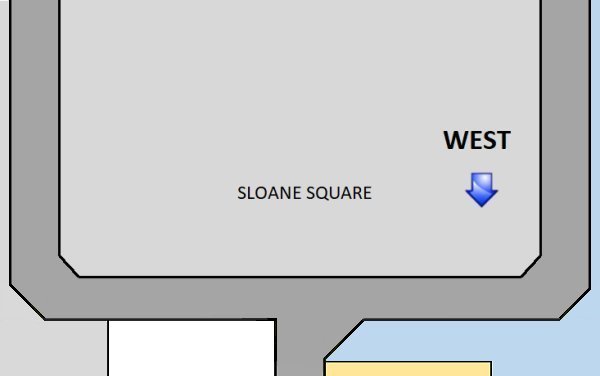 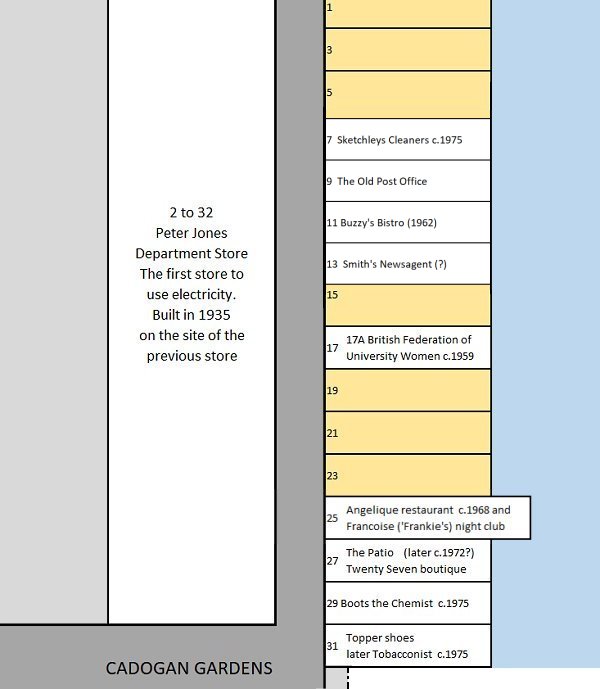 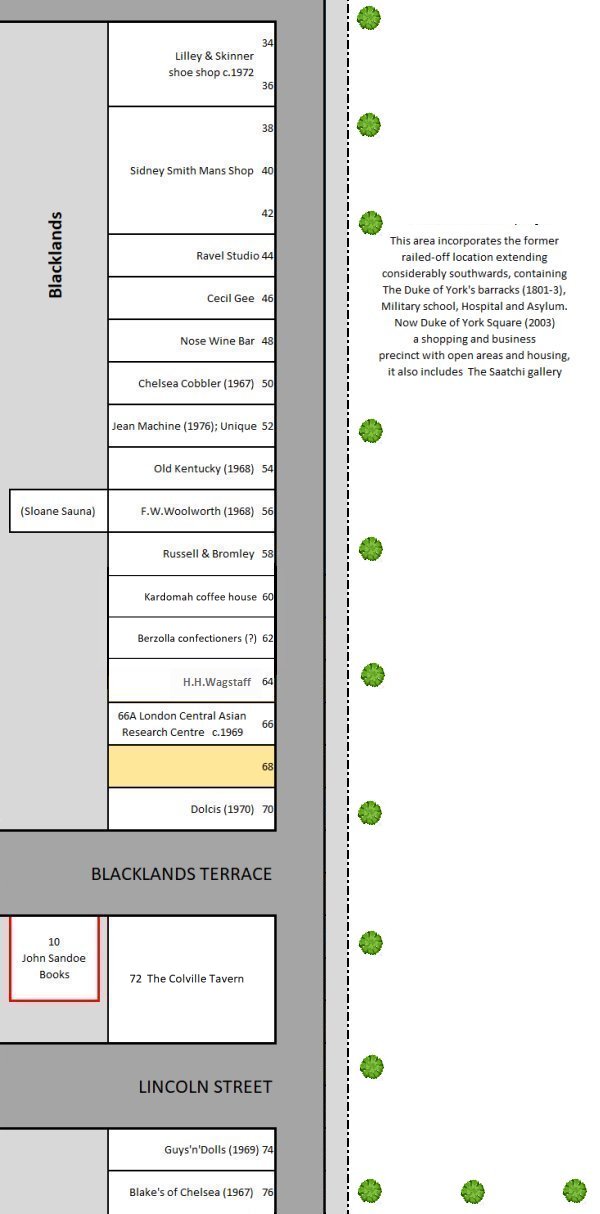 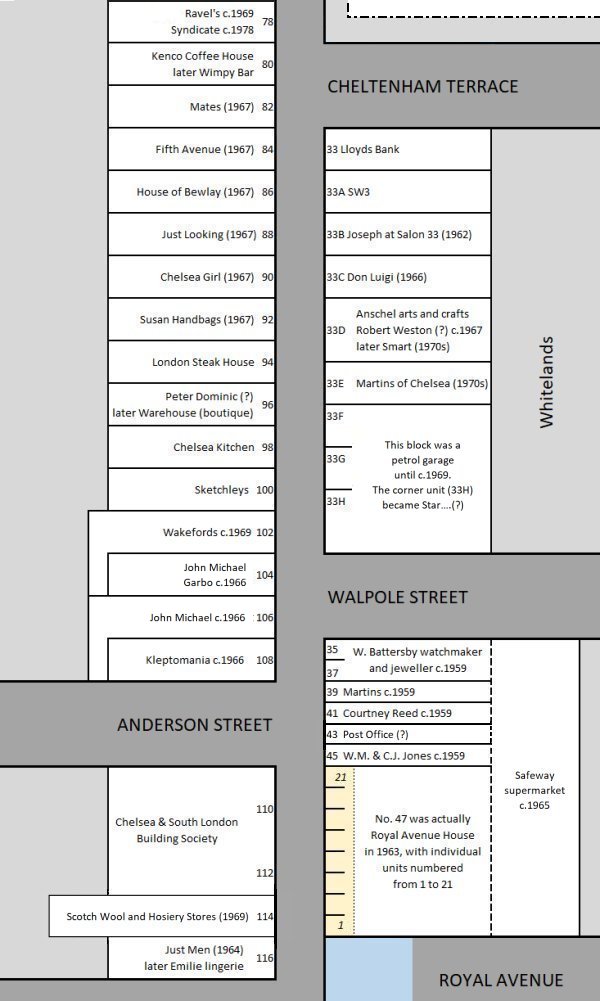 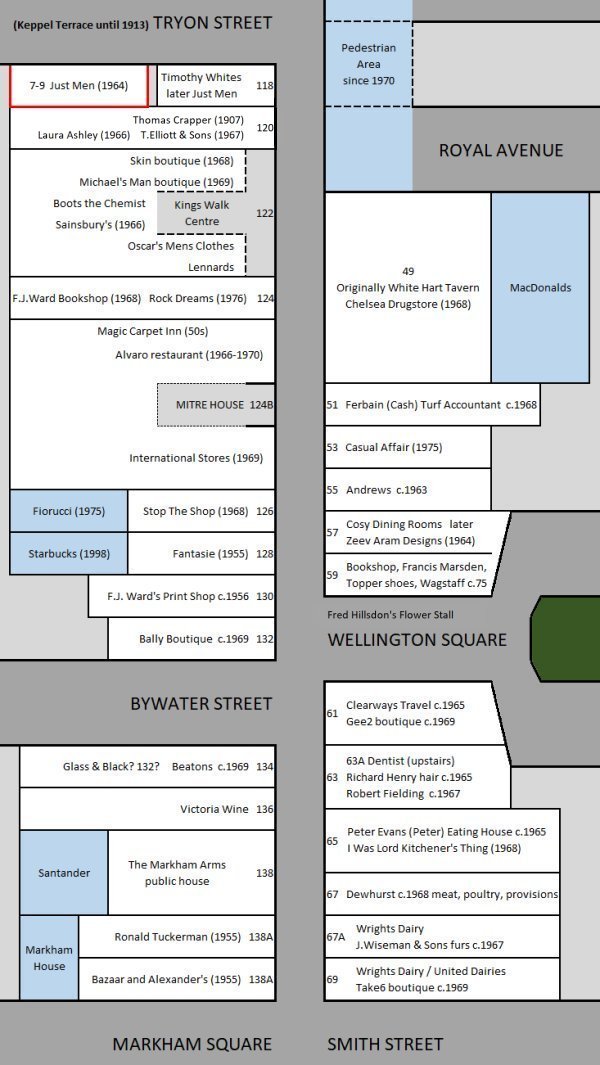 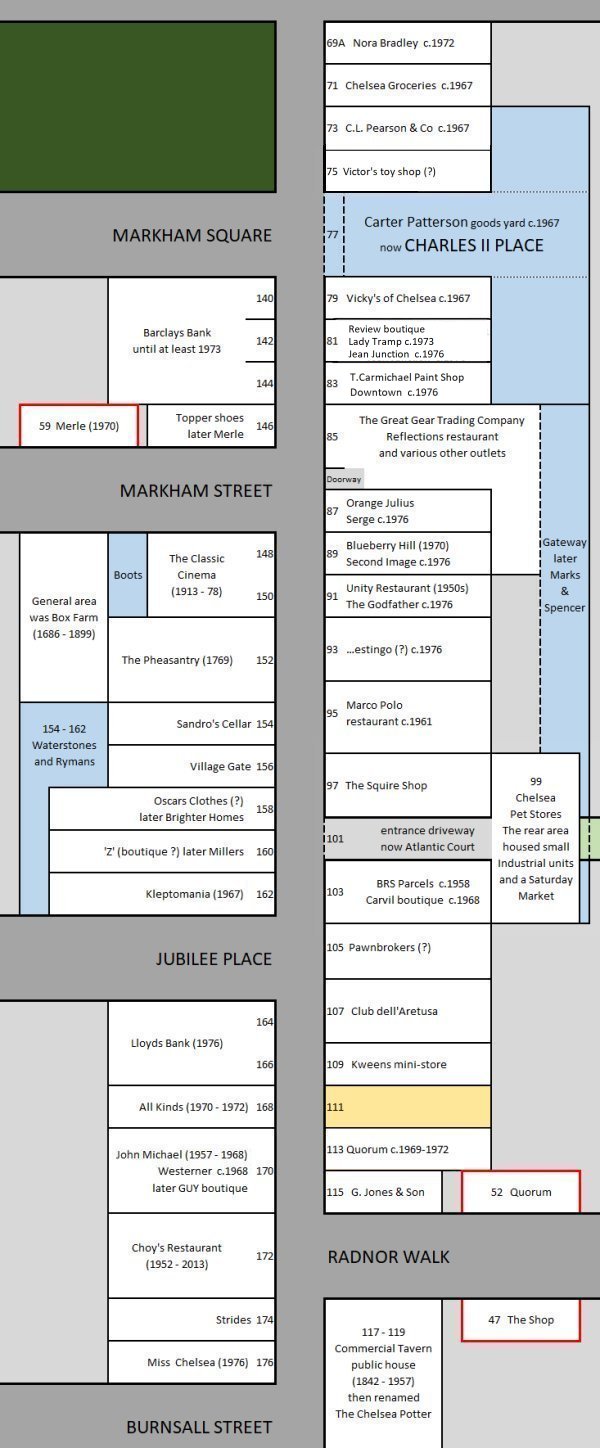 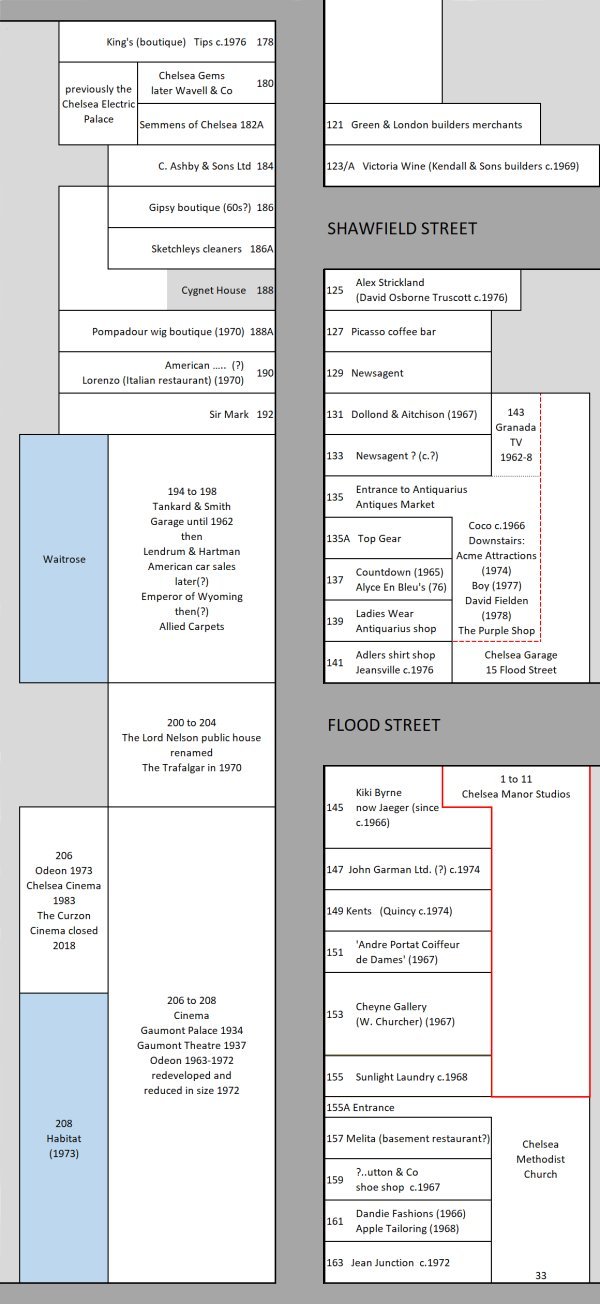 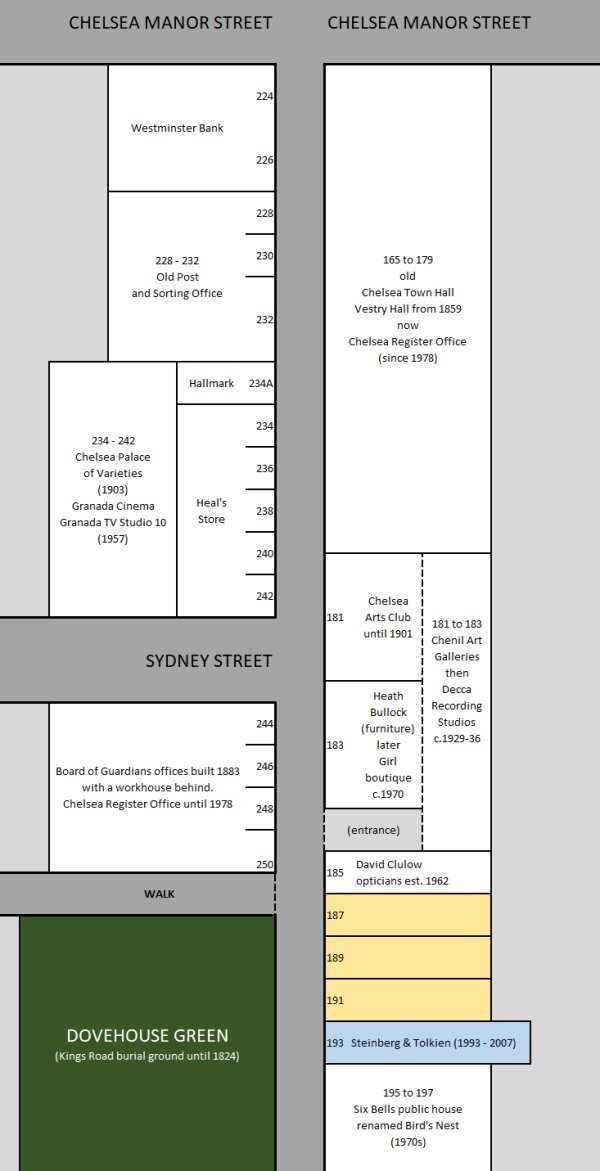 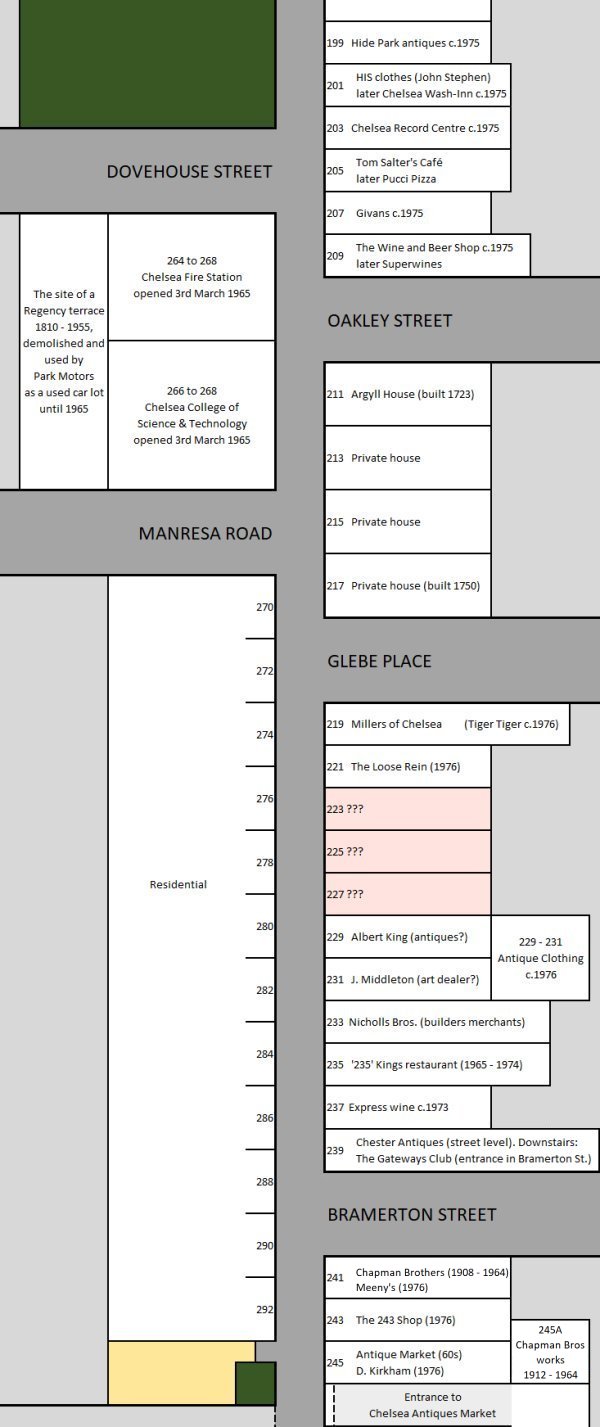 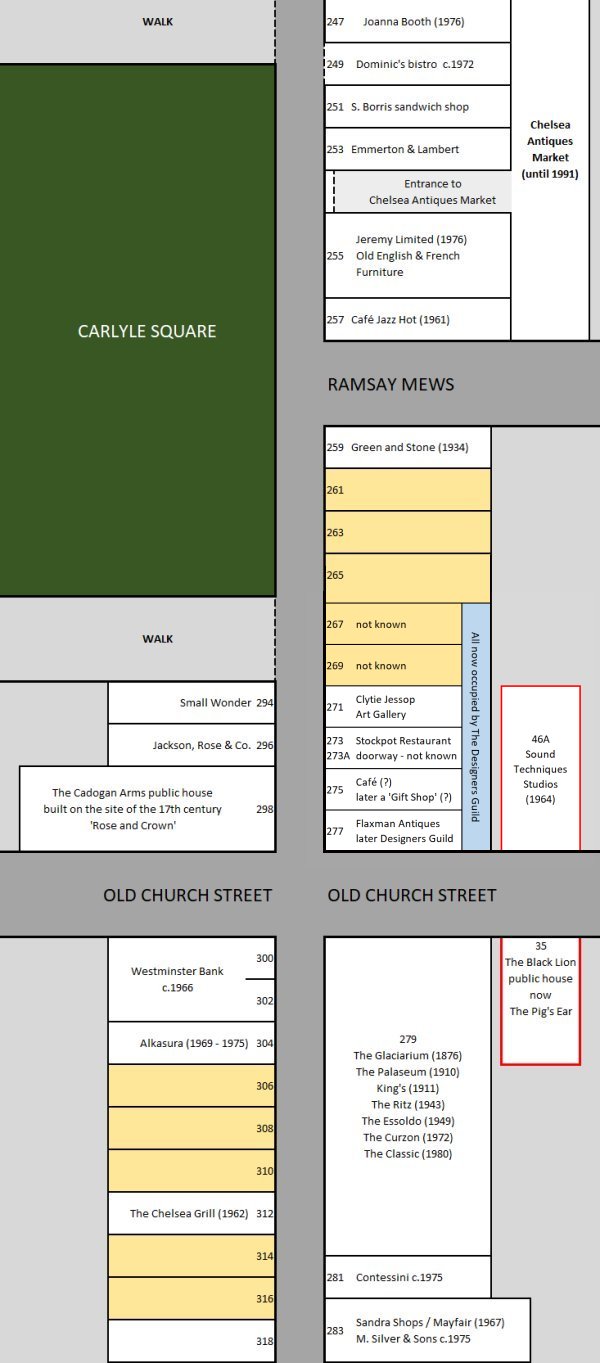 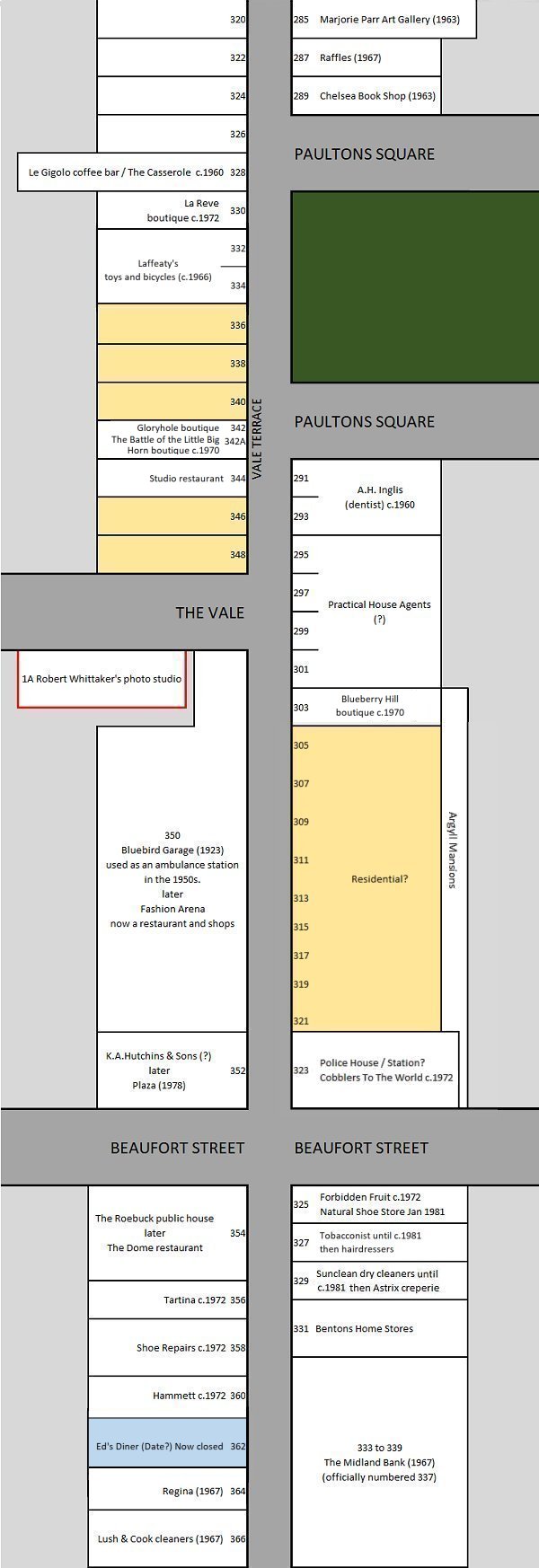 |
|
Although
constructed to the same scale, allowing all the images to be stitched
together, the following remaining map sections have been widened to
take into account the twists in the road!
They also include interesting locations in the World's End area which no longer exist, due to area remodelling, and the Cremorne Estate construction during the Sixties and early Seventies. |
|
356 Maison
Suisse Swiss restaurant c.1965 Tartina
Italian restaurant c.1965 Advert
Later Dayvilles
c.1975 357 - 359 London Co-operative Society c.1961 Later Midland Bank c.1969 358 Shoecraft Shoe Repairs c.1968 360 Hammett c.1972 street view 361 - 381 see below and list on map. Later Moravian Tower (now just '355') Street View 1961 1955 view 371 to 379 1955 view 375 to 381 View from East Side 362 Albert Debormain shop c.Aug 1960 Later Ed's Diner (1970s / 80s?) - now closed 364 Regina c.1962 - 67 1962 Advert Later Lush & Cook cleaners c.1967 365 Cullens Stores grocers & provisions c.1964 366 Laundromat cleaners c.1967 367 Heywood Engineering Ltd. c.1960 368 Ming Yuan Chinese restaurant c.1963 - 67 Later Ho Lee Fook Chinese restaurant 368 - 370 Emperor Chinese restaurant c.1970s 370 Post Office c.1961 372 Allery & Bernard car dealers c.1963 Smithy's Kitchens cafe c.1972 The Trough eating house c.1975 374 Allery & Bernard driving school c.1963 375 Gilroys fruit and greengrocer c.1955 374 - 384 Beaufort Market The upstairs 'market' was an open area divided into a number of smaller partitioned retail outlets run by different merchants and was reached by an entrance in the middle of six small shops collectively known as The Porticos. The market came to the fore in the early/mid 70s as a 'punk' gear emporium. Poly Styrene, Ollie Wisdom and Jock McDonald had stalls there and other stalls had 'punk' names such as Smutz. Fresh Slab records was owned by a Mr. White. There were major protests and almost riots when the market was closed down at the end of the 70s. Street views 1972 Boarded up c.1975 376 Allen, The Chelsea Outfitter c.1962 Later Chelsea Male c.1969 377 A.E. Wallace c.1955 street view c.1955 Between 378 and 380 was an arched entrance providing access to Beaumont Market (upstairs) and Chelsea Park - some residential buildings in a close at the rear 379 The Glaciarium (Milmans Street) 1876: The first Kings Road location of the historic ice rink (also see 279). This site is now part of The Moravian Tower complex. 380 Alkasura 1967 - 1969: The boutique was founded in 1967 by Paul Reeves and John Lloyd, but only lasted two years at this location before the partners separated. Reeves moved on to establish Universal Witness (1969-1973) on the Fulham Road while Lloyd retained the name, moving into premises at 304. Previously Ashford & Sons newsagents 381 The Moravian Church 1751: Built on the site of Beaufort House, home of Sir Thomas More. Moravian close is on the site of his garden. The Moravian burial-ground (God's Acre) was established just to the south in 1751. The Fetter Lane chapel was destroyed by bombs in 1941 and, after a period of incongruity, it was decided to re-establish the Fetter Lane Congregation at the Chelsea site in the 60s. The Close was leased to two sculptors and artists, Ernest and Mary Gillick (1914 to 1964). They hedged the Burial Ground; planted the four fig trees in the centre and the enclosing plane trees; added a new porch to the Manse; built Studio 4; divided the old Chapel into Studios 1, 2, and 3; constructed the pergola, platform and bench displaying the previous estate owners’ heraldic shields; and laid the terrace stone pathway. 382
Wm. Ashford dairy c.1939 Later Retomba
delicatessen c.1969
|
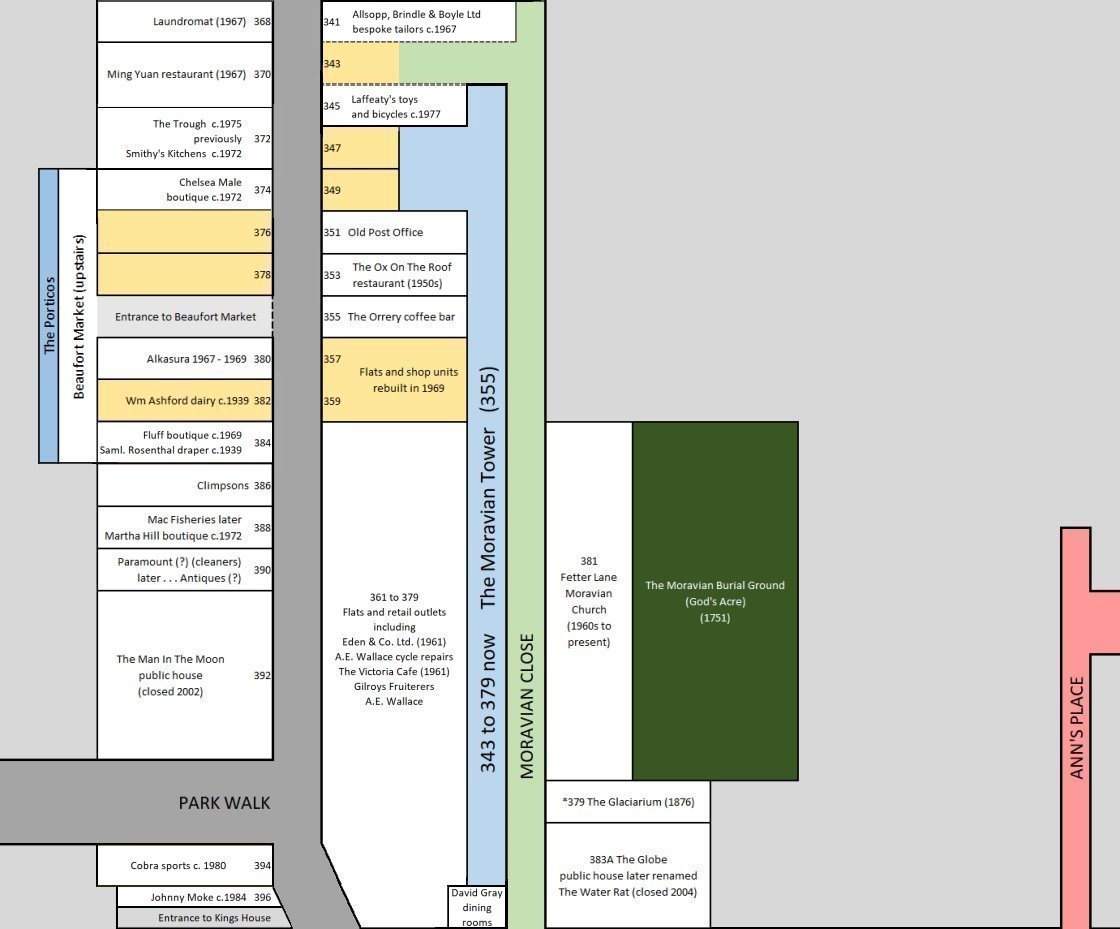 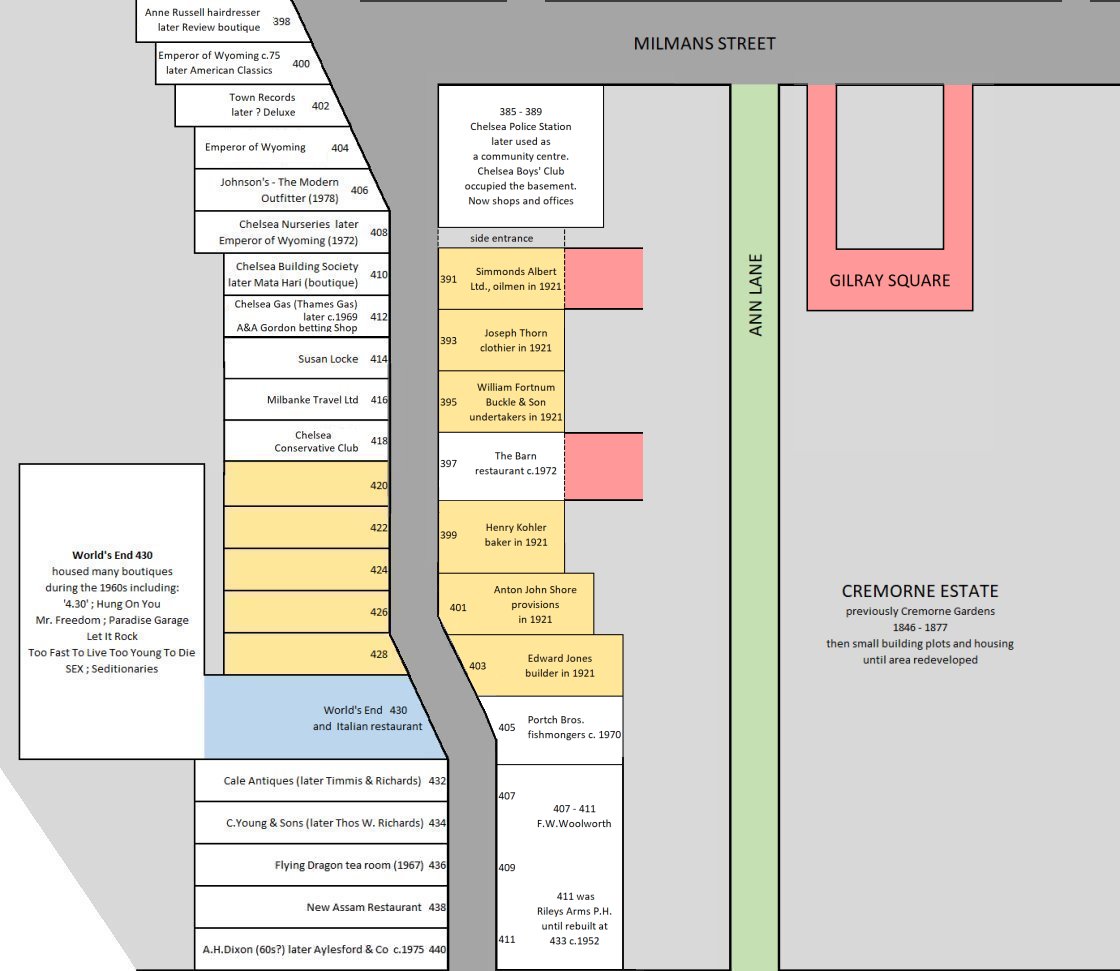 |
|
404 The Emperor of Wyoming Opened by Billy
Murphy in 1972, it focussed on the niche market already being explored
by Trevor Myles at Paradise Garage, specialising in items of Western
wear and American clothing at a time when these were hard to find in
London. There was also a branch in Notting Hill. A larger branch was
originally opened at 196 but was short-lived due to the recession. After
the closure of the branch at 196, the business moved to 400, 404 and
408 in succession. Previously another
boutique. 405 Portch Bros. fishmongers c.1970 406 Johnson's the Modern Outfitters 1978: Lloyd Johnson influenced music fashion, supplying designs to Bob Dylan, Keith Richards, David Bowie and many others. A Mod from Hastings, his beginnings were in acquiring tab collar shirts for The Beatles and The Rolling Stones at Cecil Gee's in Charing Cross. He opened his own business, Heavy Metal Kids, in Kensington Market in 1967 and Johnsons, The Modern Outfitters on the King's Road in 1978. He designed the Mod clothes for the film 'Quadrophenia'. Early Picture 407 - 411 Woolworths Store c.1970 411 was The Riley Arms pub until demolished and rebuilt at 433 during 1952 reconstruction works. 407 was Albert E. Dawson, drapers in 1921, 409 was Mark Morgan, tobacconist in 1921, 411 was Edwin Waite, beer retailer in 1921. 408 Chelsea Nurseries (shop outlet) 1967 Advert Later Emperor of Wyoming (see 404) 410 Chelsea Building Society pre 1968 Mata Hari boutique moved here from its original location at 1 Hogarth Road c.1968.Owned by John and Annette Weysom who also owned The Battle of The Little Big Horn at 342A 412 Chelsea Gas (North Thames) Later A.&A. Gordon Ltd. Betting Shop now William Hill 413 - 415 A.J.Shore Ltd butchers c.1964 1967 Advert 414 Susan Locke boutique c.1967 Susan was the girlfriend of actor Jeremy Brett in the Sixties and was one of the first stockists of Terry de Havilland's shoes. 416 Travel Planning Ltd. c.1960 Milbanke Travel Ltd. c.1965 417 Regent Cafe workman's cafe c.1972 418 - 428 An oddity with the numbering occurs here so, despite the size, Chelsea Conservative Club appears to occupy numbers 418 - 428 421 F.C.Roger & Sons butchers c.April 1967 423 Jones ? c.1967 425 Nel's Greengrocers c.1970 429 Stacey's gents hairdressing c.Nov 1960 430 World's
End Shop
432 Cale
Antiques occupied the premises during the period that 'Hung
On You' used 430. It was occupied briefly by a business called 438
New Assam Indian restaurant
c.1972
441 - 457 World's End Nurseries
458 - 474 Residential
458
to 474 street view 1975
461
(?) The
Salvation Army, previously W.J.
Pike
removals, was situated at the end of World's
End passage, between the World's End public house and the St. John
mission hall. 463 - 469 (?) Saint John's Mission: The original church was situated on Tadema Road. Open air services had been held in the area from 1873. The permanent church was opened in 1876 to serve the new development of World's End in west Chelsea. It sponsored a wide range of charitable and social activities and worked with the Salvation Army. The church was bombed in 1940 and services moved to the mission church, Saint John's Community Church, on the junction with Blantyre Street. In 1973 the parish was united with Saint Andrew's, Park Walk.
471 P.W.Wright c.1966
473 Cobb butchers
c.October 1965 Later
Decro-Cat interior
designs
475 Sophisto-Cat c.1969 The Sophisto-cat furniture store was home to Christian the lion in 1969. The animal had been bought as a cub from Harrods (you could do things like that in those days!) by the two Australian men, John Rendall and Ace Bourke, who ran the store. The store, which had acquired the cub from Ilfracombe zoo, was quite happy to part with him for a mere 250 guineas. He was a local celebrity for a year, being taken to restaurants and allowed to run around in the grounds of the Moravian church - he even took part in a Biba advertisement. When his size became a problem, his owners worked with Bill Travers, Virginia McKenna and George Adamson to return him to the wild and he was eventually released in Kenya in 1971. Previously Edmund R.Goodrich Ltd domestic stores c.1961 premises bought by K&C council March 1966 477 Starways 478 Todds hairdressers c.1968 owned by Gary Craze 479 Lasenby & Co. Ltd. furniture c.1960 60 Advert Later Tobias Records c.1965 1965 advert Later Memphis Soul Pad records c. Sept 1968 480 Arnold & Ambler publications c.1964 481 Quick Nicker later Rayner, Davies & Co Ltd c.Sept 1965 483 Newspaper Shop c.1959 bought by Tony Tobias. Stocked toys etc. from c.1960 as Field 1964 Advert 484 British Legion Chelsea Branch c.1965 Later Swan Song Records: The headquarters of Swan Song Records, started by Led Zeppelin on 10th May 1974 following the end of their contract with Atlantic Records. The label was discontinued for new releases in 1983 but the company still exists for reissue of previous recordings. 485 World's End Pharmacy 487 Speed Queen
488 Granny
Takes a Trip 1965 - 1974.
490 Sunlight Laundry c.1970
492 Davisons
off licence c.1974. Previously Lesters and Unwins? View
of Davisons from Langton Street 1975
502 Vogue Cleaners
c.1961 Jon-Jo's
books, games and toys c.Oct 1964 Chelsea
Scooters c.1966 (?)
507 El
Cheapo previously A.Rollo
and Sons 509
Davis & Cruchley 511
R.Evans & Son Later
Chemist
519 - 529 Not Known Empty Lot (?)
531 Oddbins
wine merchants c.1969
535 Cube Records 1972: This was
the headquarters of an independent record label launched on 26th May
1972 by music publisher David Platz and was also his UK office for
Essex Music. The Cube label folded in the mid 1970s, becoming part
of Elektra Records. The building has since been demolished and the
new 'Plaza 535' building still houses the Essex Music group.
541
Formerly the Nell Gwynne public house until 1944 and,
at various times known as Come The Revolution and One
/ Pulse Bar
555
Shoe Repairs prior
to c.1957 559
Cosy Corner Cafe workman's cafe c.1972
574 Guinevere
Antiques Founded in 1963 by Guinevere Weaver - Later occupied
574 - 580
580 ...e Mostyn (?) Second hand furniture c.1963
583 Antiques
585 Not
Known 587
Thomas 594
New Calcutta Indian restaurant c.1972
617 Hand
& Flower public house 1869
648 Lord Palmerston public house c.1874 (then at 'Schofield Terrace'). Later 'The Morrison' until 2011
|
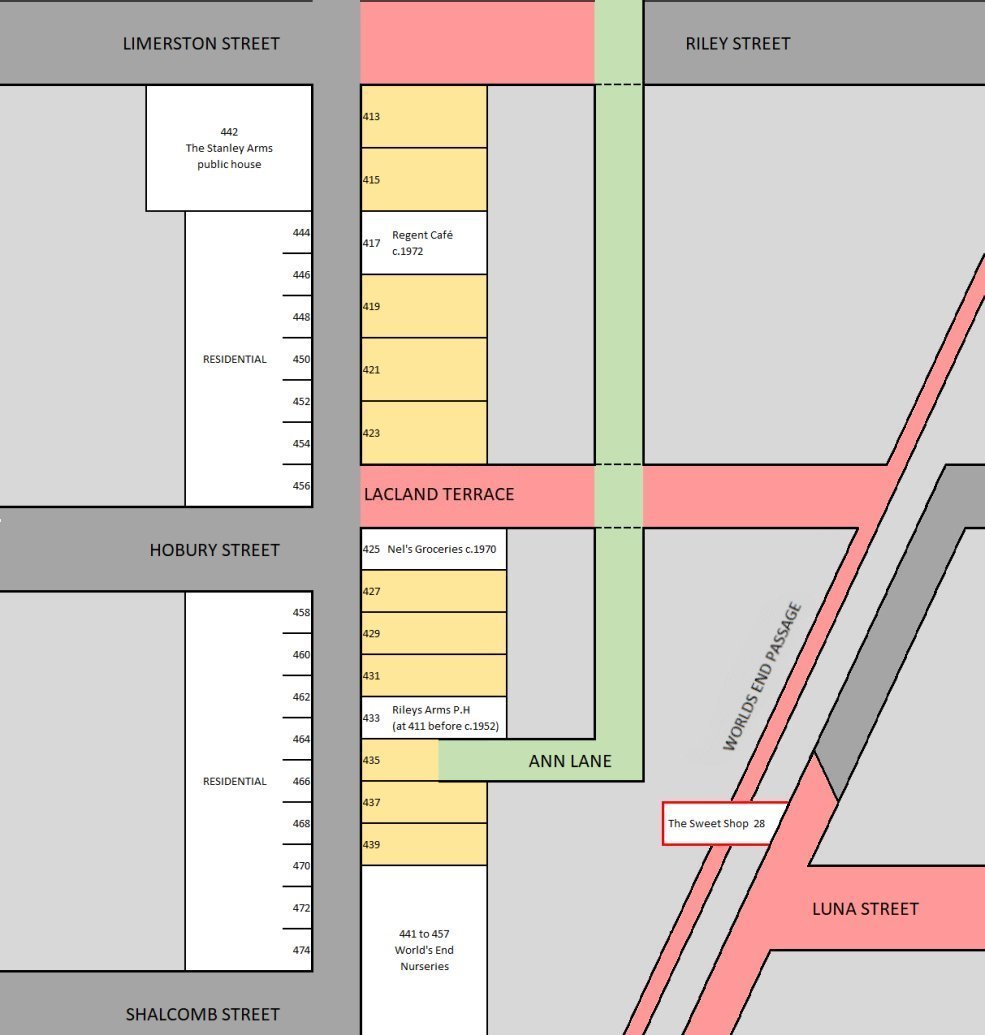 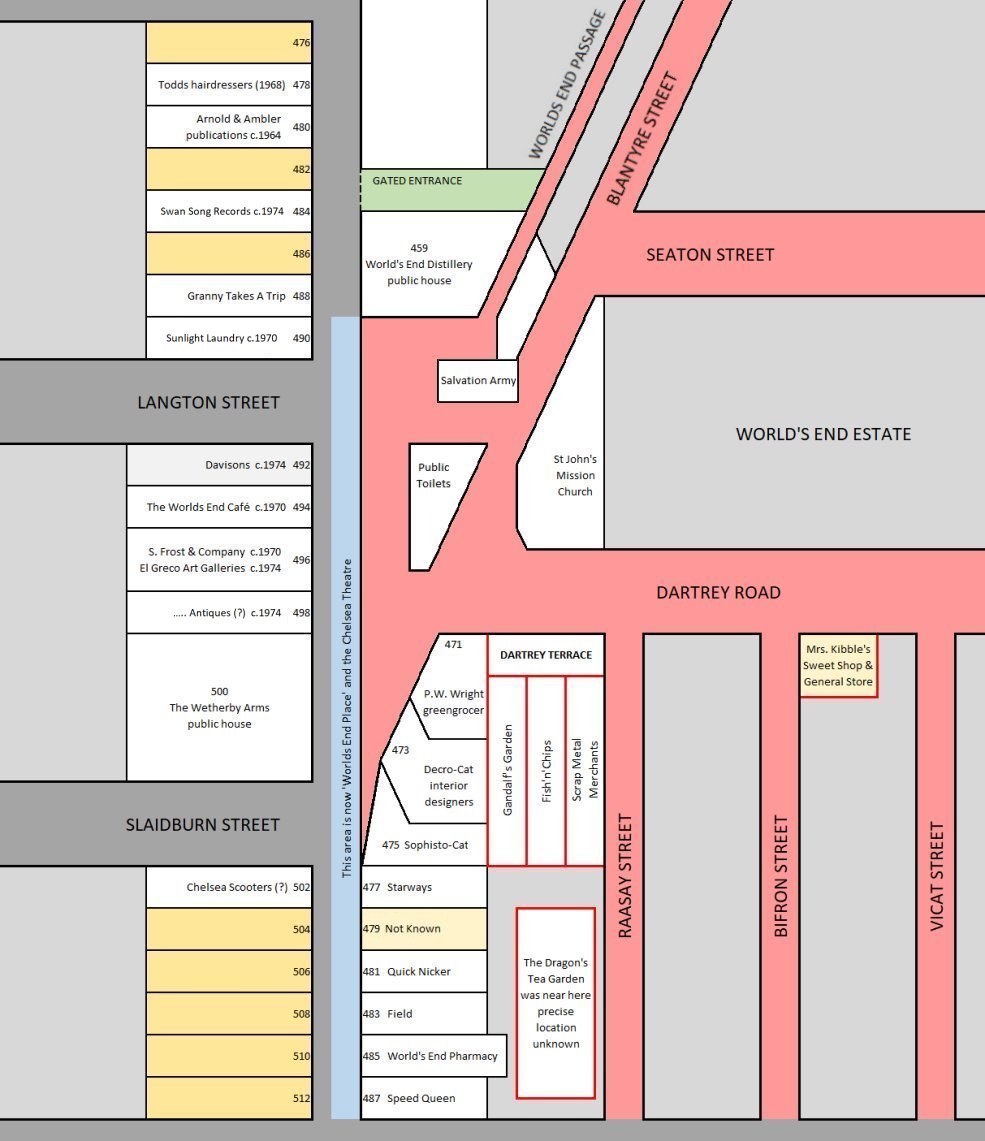 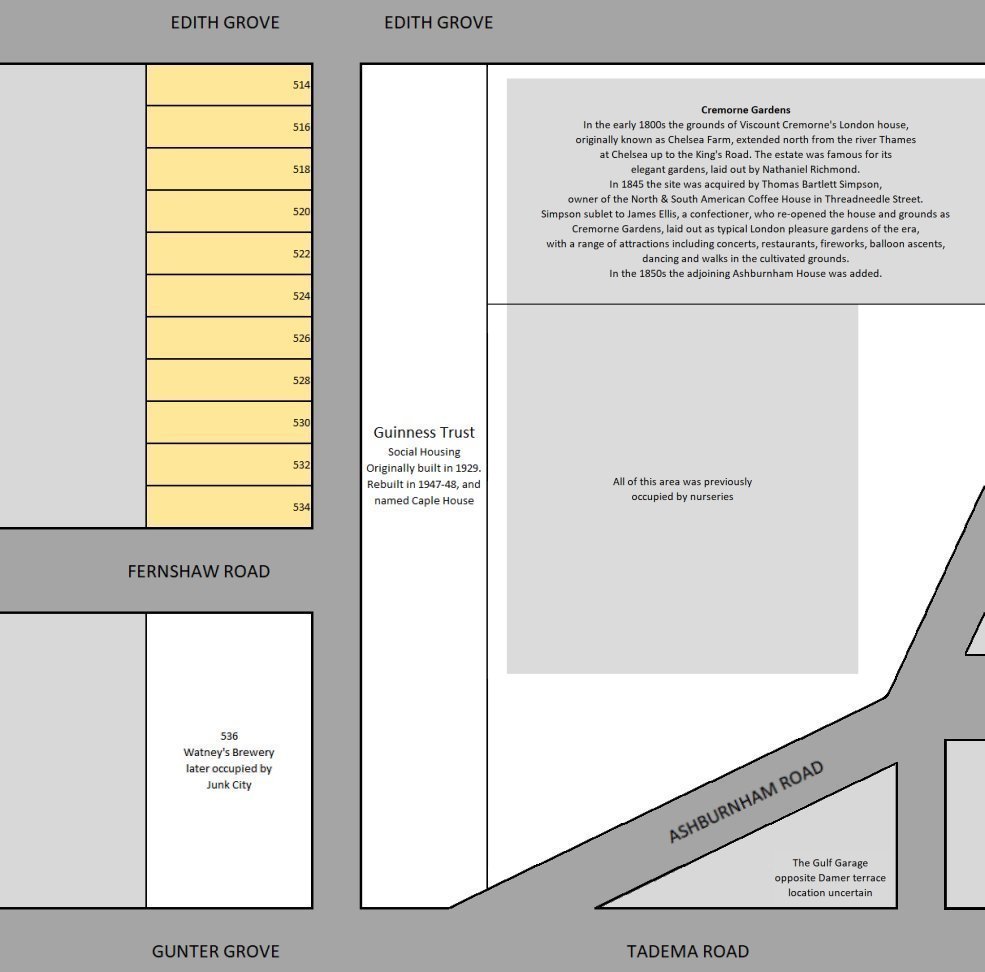 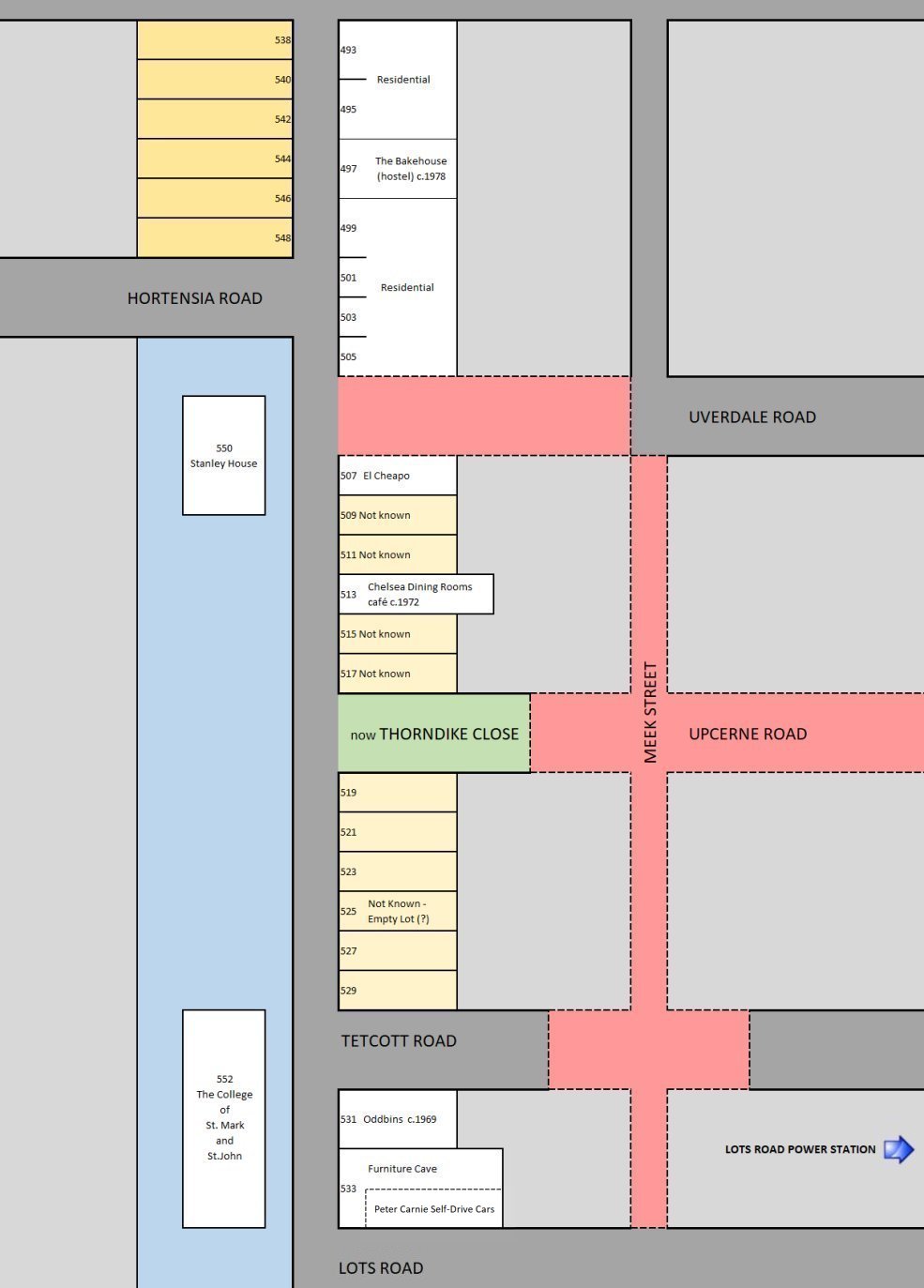 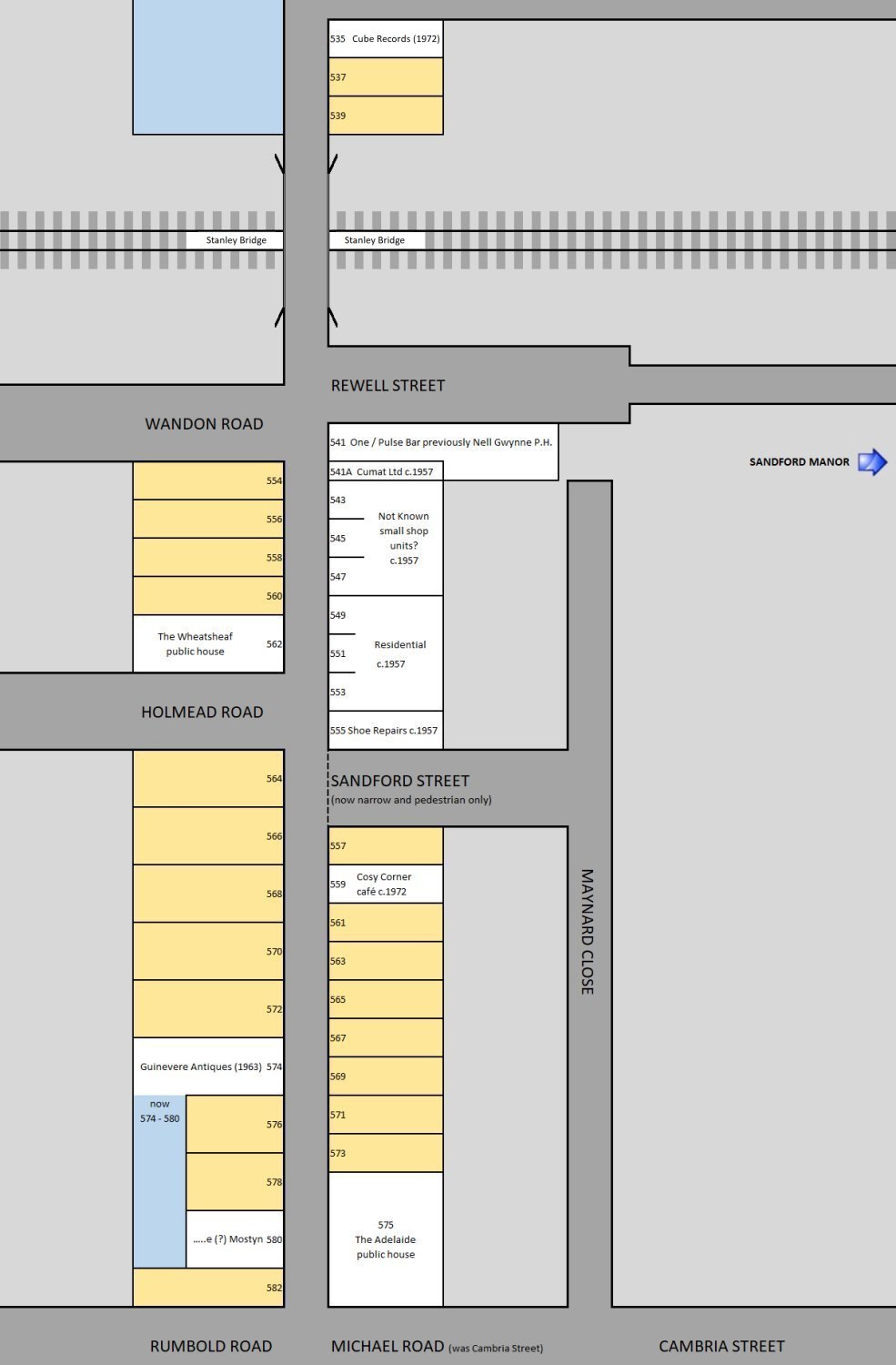 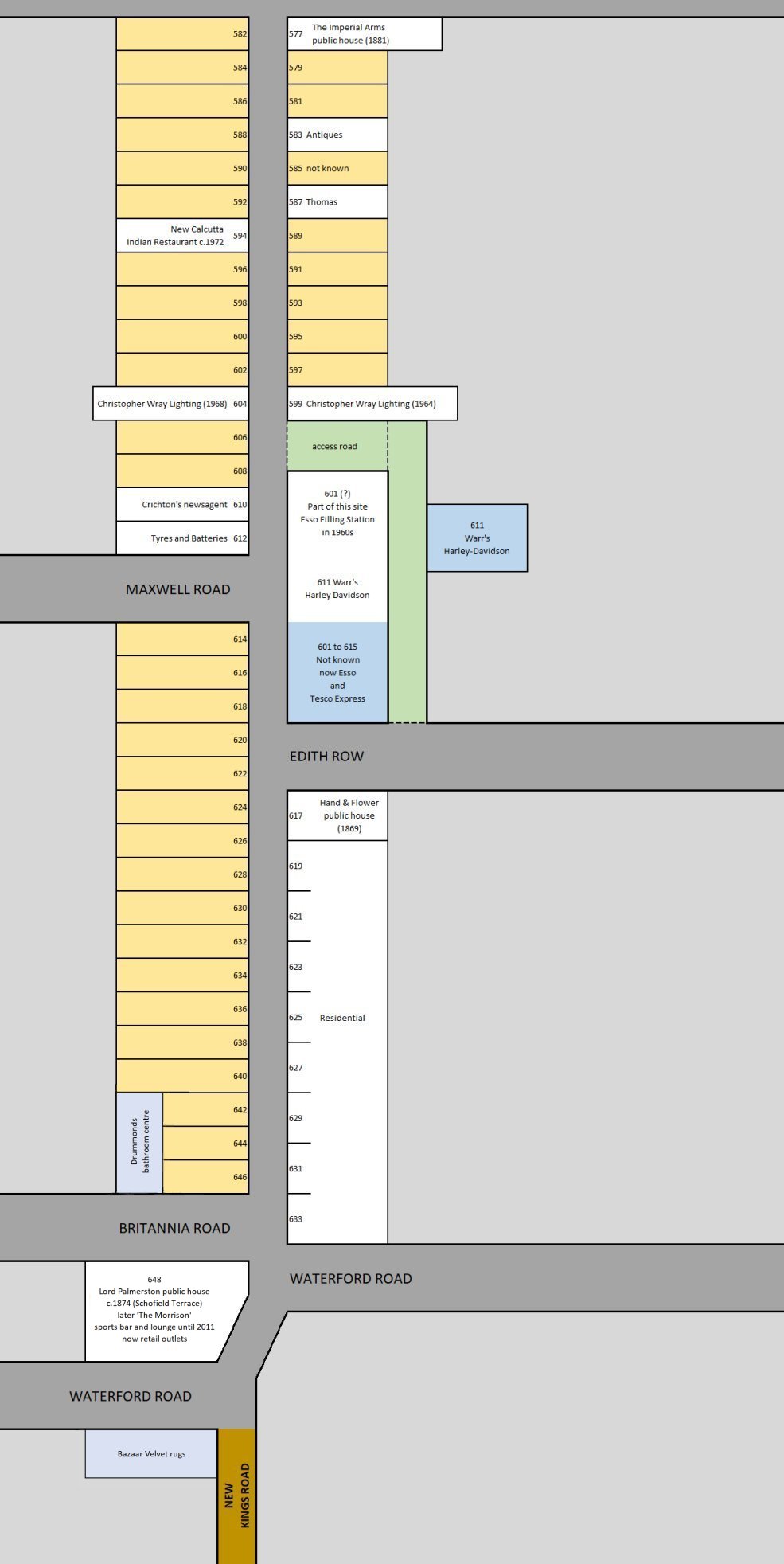 |
|
|
All
Original Material Copyright SixtiesCity
Other individual owner copyrights may apply to Photographic Images |